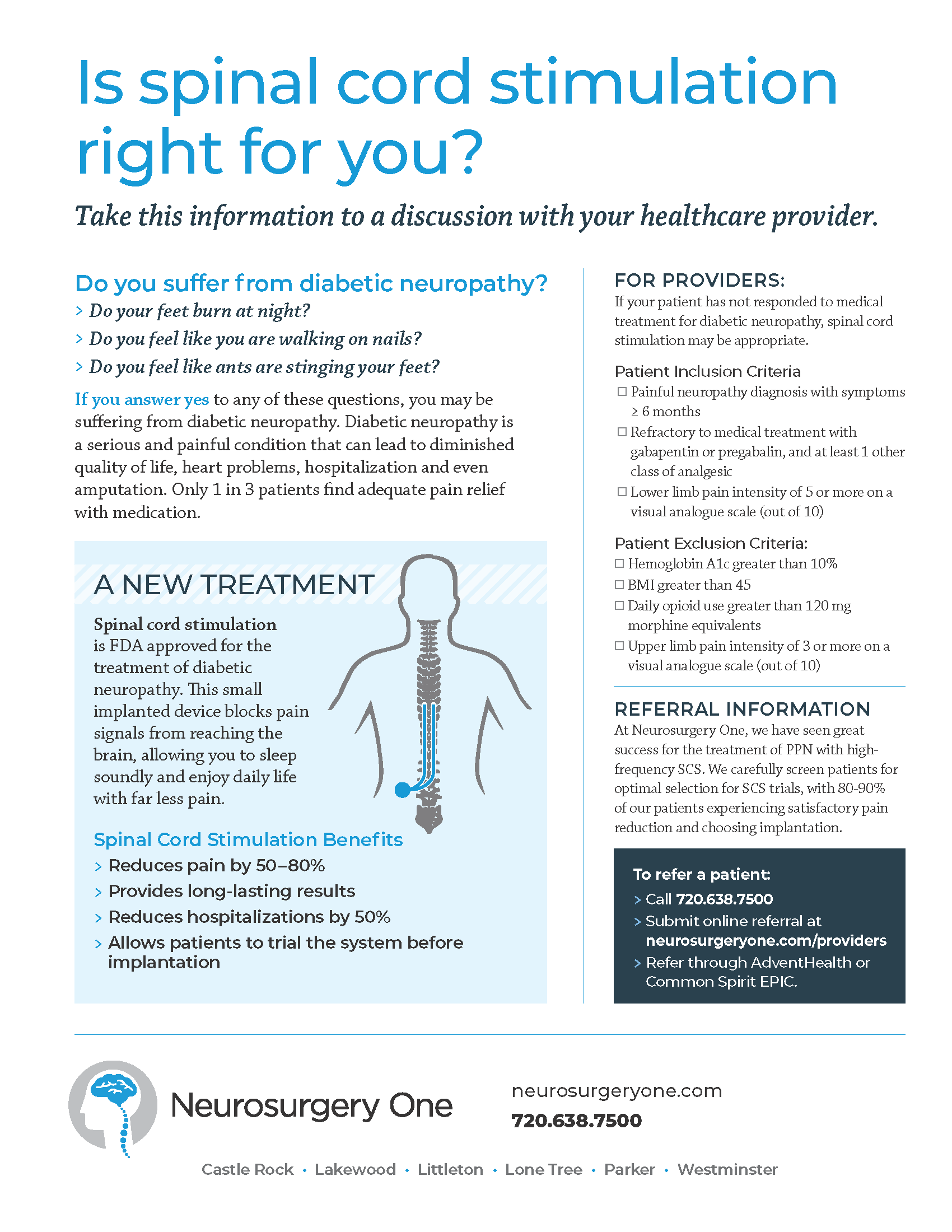
Do your feet burn at night? Do you feel like you are walking on nails? Does the touch of a sheet cause pain?
If so, you could have diabetic peripheral neuropathy.
Diabetic neuropathy can cause debilitating pain in the hands and feet, significantly impacting your quality of life. Diabetic neuropathy is treated first with medications, but medication is effective for only 1 in 3 patients. If you have painful diabetic neuropathy and medication doesn’t work to control your pain, you may be a candidate for a minimally invasive treatment called spinal cord stimulation. Continue reading to learn more.
Talk to your primary care provider

If you are suffering with painful diabetic neuropathy and medications haven’t helped, the first step is talking to your healthcare provider about spinal cord stimulation as a treatment option. Download this flyer to guide the discussion, including information for your provider on how to refer you for spinal cord stimulation.
Download Flyer
Are you a candidate?
Spinal cord stimulation is an implanted device to treat painful diabetic neuropathy by interrupting the pain signals from reaching the brain. Customized for each patient, spinal cord stimulation helps you sleep better and enjoy your daily life with far less pain. You may be a candidate for spinal cord stimulation if you answer yes to these three questions:
Get Started Today!
Ready to find relief? Begin your assessment with one of our specially trained nurse practitioners or physicians assistants who can obtain the necessary tests and, if you are a candidate, schedule your spinal cord stimulator trial. If you find satisfactory pain relief during the one-week trial, you could complete your treatment within six weeks or sooner!
What are the benefits of spinal cord stimulation?
Spinal cord stimulation is an effective therapy that relieves pain by 50% or more for appropriately selected candidates. Other benefits include:
- Reduces or eliminates the need for pain medication
- Reduces the risk of hospitalization by 50%
- Temporary trial ensures that the treatment works BEFORE undergoing implantation surgery
- Relief is long-lasting, with studies showing no increase in pain after 8 years
Watch a Patient Story

Common questions about diabetic neuropathy and spinal cord stimulation
- How does spinal cord stimulation work to control diabetic neuropathy pain?
Spinal cord stimulation (SCS) is a minimally invasive therapy that uses an implanted device that uses electrical impulses to interrupt pain signals from reaching the brain. So while the cause of the pain still exists, the feeling of pain does not. Boston Scientific, the manufacturer of the SCS system used by Neurosurgery One, has shown that more than 75% of patients will find relief, with 90% experiencing relief for at least three years. You can get additional research about Boston Scientific’s Wavewriter Alpha SCS system on the company’s website, where you also can find additional resources including videos and be connected to patients who currently use SCS to control their pain.
- What does diabetic neuropathy feel like?
Diabetic peripheral neuropathy is most commonly felt in the feet. It can be sporadic or constant and feels different in different people. Most people with diabetic neuropathy will answer yes to one of these questions:
- Do your feet hurt at night? Are sheets irritating or painful?
- Do you feel like you are walking on nails, broken glass or marbles?
- Do you feel like ants are stinging your feet?
- Does it feel like your feet are on fire?
- How common is diabetic neuropathy?
More than 38 million American adults live with diabetes, including nearly 9 million who are undiagnosed, according to the Centers for Disease Control and Prevention. Of these, half suffer from diabetic peripheral neuropathy, which is associated with substantial risk for pain, foot ulcers and lower limb amputation, according to a 2019 study published in Current Diabetes Reports .












